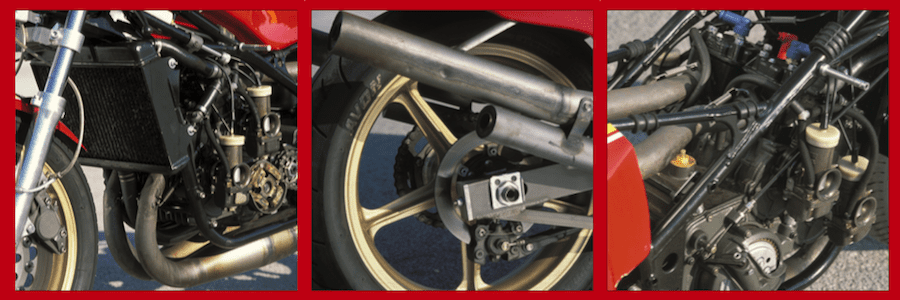It was the two-stroke Suzuki too powerful for its own running gear. But with a little advice from the late, great Barry Sheene, Sir Al managed to tame the RG700
Often loosely referred to as the RG700, Suzuki’s steroid-laden superbike was originally conceived in 1976 as a testbed to advance development of the Japanese company’s XR14 500GP contender. This was the start of Suzuki’s mid-70s GP domination, with Barry Sheene the first man to win the 500cc world title for the marque in 1976, retaining it in 1977.
Barry’s first title was earned on a bike with the classic ‘level’ cylinder configuration for its RG500 square-four rotary-valve engine. But that year Makoto Hase and his Suzuki R&D team developed a larger 652cc version with overbored stepped cylinders and a cassette-type extractable gearbox – both avant-garde race features. The extra capacity initially delivered too much power for the flimsy chassis and skinny rear tyres of the period to handle, so it was detuned to a less extreme 101kW (135hp) at 10,800 rpm, still the first bike ever to deliver the coveted 1:1 hp/kg power-to-weight ratio. It was much more powerful than any other racebike of the day, and a lot more than the 85kW XR14. In fact, it became the first modern racer to break the 300km/h mark when trapped at 303km/h at Fuji Speedway in testing.
Suzuki’s view of the XR23 was as a rolling testbed for its 500GP program so it wasn’t homologated for World Championship Formula 750 racing, which at the very least would have required a spurious attempt to construct 25 street versions, as Yamaha had pretended to do (but never in fact did) in order to make the TZ700/750 eligible. Instead, four bikes were built and hastily air-freighted to Britain just five days before the April 1977 Transatlantic Match Races – one each for Texaco Heron teamsters Barry Sheene and Steve Parrish (riding for the British squad), plus a spare for Bazza, and a fourth bike for American Pat Hennen. Although it was Sheene who gave the XR23 its debut race win, Hennen finished top scorer for the series. Suzuki then left the four 652cc bikes in Britain for them to race in the 1977 Superbike series, and were rewarded with the series title for Sheene with four race wins, and two more for Hennen en route to third.

It was a satisfactory debut season for Suzuki’s project bike, which led to the 1978 debut of the factory’s all-new XR22 500cc GP contender, which adopted the same stepped cylinder format and cassette gearbox. But it came without the ten-pound iron bar that Barry had fitted to his bike to keep the front wheel more or less in contact with terra firma when exiting turns!
Also for 1978, Suzuki produced an uprated maxi-racer, the XR23A, with then-experimental Nikasil-coated cylinders. Top speed at Fuji was now 309km/h, though power was the same and dry weight unchanged at 136kg, while the chassis and suspension were identical to before, but with slightly bigger 300mm front brakes. Again, the bikes were raced mainly in the UK, with Hennen once again finishing top overall points scorer in the Transatlantic Match Races. He had apparently learnt the set-up tricks of the Golden Shocks better than Barry, one reason for his success alongside his equal mastery of the wheelstanding rodeo racer’s rush of power. But it was Sheene who retained his MCN Superbike series crown with six race victories, after the American sadly suffered his horrific career-ending injuries in the Isle of Man TT.
Hennen’s enforced retirement meant that there was a spare XR23A available, and this was entrusted to Dutch white knight Wil Hartog for the rest of 1978, culminating in his beating Barry to win the final round of the MCN Superbike series at Brands. After this, Hartog was given the bike painted in his trademark Riemersma livery for the whole of the 1979 season, with Tom Herron joining Sheene and Parrish in the Texaco Heron team racing in the UK, while a fifth bike was confided to Roberto Gallina’s Olio Fiat NAVA team to race out of Italy.
This machine, like the others, was fitted with a new exhaust system incorporating longer silencers to meet the new, lower 105dB noise limits introduced that year – which presented Suzuki’s engineers with the problem of how to fit these without them extending back beyond the rear tyre, illegal under FIM rules. Solution: curve the expansion chambers for the rear cylinders initially up, then downwards around the twin rear shocks, and finally out and back. The ugly-looking but effective result produced 2kW more via revised porting of the Nikasil cylinders, so power was now up to 103kW, still at 10,800rpm. A brake package needed to cope with the XR23B’s explosive performance was now also fitted, comprising 310mm twin floating front discs and a single ventilated 220mm rear.
Read the full story in the current issue (Vol 67 No 13) of AMCN on sale now
TEST ALAN CATHCART
PHOTOGRAPHY KYOICHI NAKAMURA
